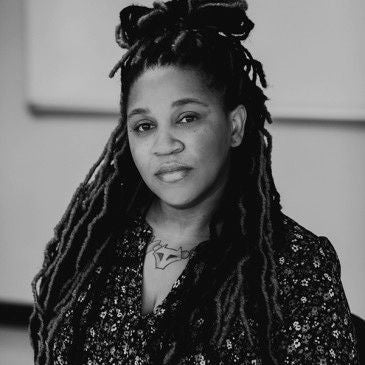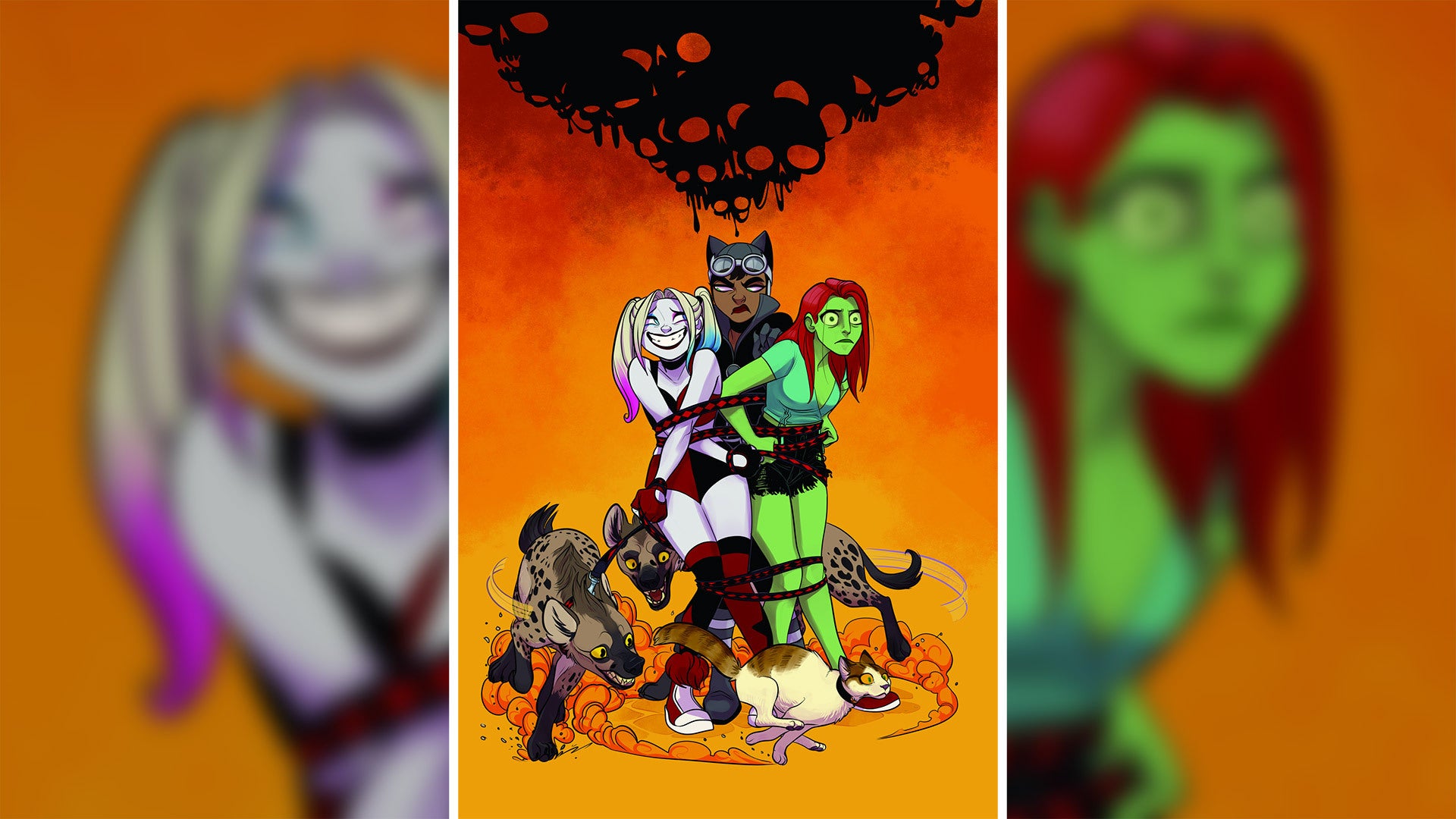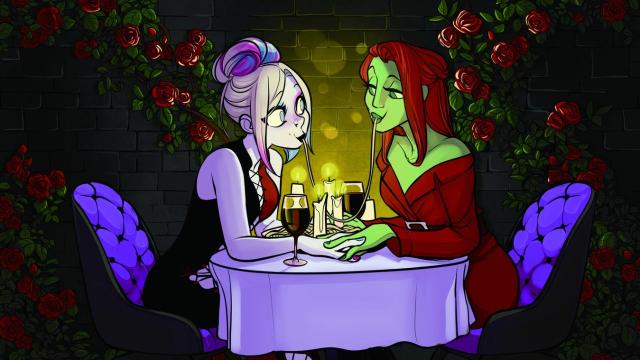Harley Quinn: The Animated Series is hands down my favourite piece of DC Comics media. The show’s sharp, raunchy writing, alongside its thoughtful characterizations of Harley and the rest of Batman’s rogue’s gallery, have injected new life into these once-familiar characters for me. It also doesn’t hurt that the characters curse, the action dips into ultra-violence, and the show isn’t afraid to dial up the sexy.
Season 2 is in the books and season 3 is on the way, but fans won’t have to wait for its arrival in order to fill the mallet-shaped hole left by the Clown Princess of Crime’s TV show. In fact, Harley’s misadventures have already continued in a new comic spin-off, Harley Quinn: The Animated Series: The Eat. Bang! Kill. Tour.
The comic serves not only as an off-shoot to the TV show, but also as the DC Comics debut of its writer, Tee Franklin. I spoke to Franklin about her journey in the comic book industry as a Black, queer, disabled, autistic woman, and how she used her interpretation of Harley Quinn to challenge the ways comic books have often perpetuated harmful ableist stereotypes.
Black. Queer. Disabled. Autistic. Harley Quinn writer.
Never have I EVER thought that I’d write for DC Comics, yet here I am. And on Harley frickin Quinn! Biiiittttccccchhhhh
Lemme throw my stunner shades on pic.twitter.com/9VVBM7frPF
— TEE FRANKLIN IS WRITING. JOIN MY PATREON (@MizTeeFranklin) August 3, 2021
The Eat. Bang! Kill. Tour takes place hot on the heels of the show’s season 2 finale, in which Harley and her new girlfriend Poison Ivy go on the run from Jim Gordon after Ivy was left at the altar by Kite Man. In an effort to cheer up her plant-based sweetheart, Harley decides to take her on an old-fashioned road trip. Naturally, chaos ensues.

Franklin got her start in comics interviewing comic book writers and artists and promoting their work through Black Comics Month, a recurring panel she would host at comic book conventions. She cut her teeth as a writer with “The Outfit,” a short story in issue 27 of Image Comics’ Nailbiter, after interviewing one of the series’ writers, Joshua Williamson, at New York Comic Con. She also wrote the critically acclaimed comic Bingo Love, about two Black women in their 60s who rekindle their teenage romance.
Franklin said she was drawn to pitch her concept for a Harley Quinn comic after seeing how The Animated Series handled the Joker’s abuse of Harley, and her response to it. As a survivor of domestic abuse, Franklin said she lived vicariously through Harley’s handling of her breakup, especially the memorable moment when she busted Joker’s nuts with a bat. Franklin wanted to focus on the emotional trauma that both Harley and Ivy experienced throughout the show, something the characters were dealing with in harmful ways.
“We all have our trauma,” she said, “and we have to deal with it in one way or another. Some of us stuff it down, which is currently what Ivy is doing. When you continually stuff things down, it’s the little things that piss you off.”
The dynamics offered Franklin an opportunity to explore the ways in which unexamined trauma can interfere with our efforts to form new, healthy relationships. She said Harley wants to help Ivy so badly, but initially, if Harley so much as snores too loudly, it’s enough to make Ivy angry because she hasn’t confronted the trauma of her last relationship in a real way.
Harley and Ivy are longtime friends on the show, but when it comes to their burgeoning romantic relationship, Franklin said they still have a lot to figure out. Especially given that they drunkenly had sex for the first time during Ivy’s bachelorette party.
“I really wanted to show that it’ll eventually be a happily ever after, period, for Harley and Ivy, but it’s going to take a minute to get there,” she said. The comic book format allowed her to take a different, more introspective approach than the show, one that takes its time with the couple’s newfound emotional intimacy. Franklin was excited to write what she wanted to see from the couple, how their relationship develops and, with it, how they express their love for each other in healthier ways.

The double entendre you might find in the comic’s title is no mistake. There’s plenty of ‘eating’ and ‘banging’ to go around here. “I am beyond shocked by the things that I got to do in this comic. I mean the first issue [Harley] cartwheeled on the coochie,” Franklin said.
While the comic’s raunchiness rivals that of the show, Franklin didn’t push the envelope so far as to have DC call her up and say “Tee, you tripping.” Any disappointed readers might have to campaign for a director’s cut. Nevertheless, it’s wonderful to see queer female sexuality depicted openly and shamelessly, especially for Harlivy. Such depictions still feel rare and almost revolutionary to encounter in mainstream comics.
Franklin was also very deliberate about making the comic’s supporting cast a diverse bunch, and not just in terms of race. The cast includes people with disabilities, neurodivergent folks, sex workers, and older people (including a possible cameo from Bingo Love’s Hazel and Mari in issue two).
When given the opportunity to write Harley Quinn, Franklin said she was going to have “everyone and her mama” represented in the comic. As a disabled and autistic woman, she said it was important to depict a world that looks like her own. Having a diverse cast of characters also meant avoiding racial and ableist stereotypes that are often thoughtlessly included in comics.
“When you think of Harley, there’s always this adjective of her being ‘crazy.’ That is a very harmful word. I have depression. I have PTSD. I got the alphabet, but I’m crazy? No,” Franklin said. “I wanted to use this book to show, not just the people reading, but the editors and writers across the board that y’all don’t need to use this ableist language to get your point across.”
Although Franklin admits to not being a “$US10 ($14)-word girl” or even a “$US5 ($7)-word girl,” she said the comic book industry needs to expand on the adjectives it routinely uses and avoid employing terms like “lame” and “dumb” as insults because of the ableist nature of doing so.
“I’m lame. I use a walker [and] I use a wheelchair. Lame doesn’t mean corny because I am far from corny, baby. For this book to not have any of these ableist terms is groundbreaking because you can do so much more without putting disabled people down,” she said.
While Franklin wishes she could fully celebrate her accomplishment of writing for an iconic comic book character, her joy has been tarnished by the torrent of online harassment hostile comic ‘fans’ have sent her. This harassment is something Black creators often experience when they enter a mainstream space that doesn’t have a lot of people who look like them in it.
If given another opportunity to write for DC, she said the one thing she would do differently is not interact with the fans. “Black people always get crapped on,” she said. “Having somebody tell me that I can’t write white characters because I’m Black really hurt because on the flip side, white people can write every character underneath the sun, every race. But I can’t. Why can’t I?”
The harassment and death threats caused so much hell for Franklin that she sometimes wished she’d never agreed to write the comic.
“I see why a lot of comic creators, they just dip and they leave social media because it’s too much. The stuff that I was getting, I would not wish that on anybody,” she said. She was able to weather the storm of hate thanks to her editors and the fans who have been kind to her throughout her journey. While she was in the hospital for heart surgery, she said her editors and staff were especially supportive as she wrote issue three of the comic.
“They easily could have said, ‘Peace Tee, we ain’t sign up for this,’ but they didn’t. My editor, Katie Kubert [asked], ‘What can we do?’ ‘How can I help you?’ ‘What do you need?’ And that’s something that as a disabled person, you’re not used to. We’re used to making ourselves smaller [and] apologise profusely when things are out of our control,” she said.
As a black girl from the hood of Patterson, New Jersey, writing a story about two queer women running from the cops for such a major comic publisher was a surreal experience for Franklin. She hopes that it’s indicative of larger changes to come in the comic book industry.
“I’ve gotten messages from queer kids and I’m like, ‘y’all shouldn’t be reading this book, but ok.’ But that impact is good,” she said. “I’m really hoping that DC, Marvel, Image, everybody just starts realising and hiring disabled talent. As long as you make things accessible for us, we will give you the best of us.”

Leave a Reply